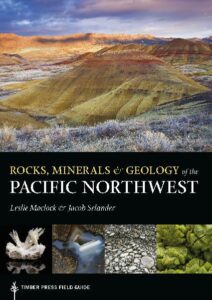By Melissa Wagoner

The Pacific Northwest is a land of movers and shakers – when it comes to geology that is.
“The PNW is known as an active margin,” geologist Leslie Moclock described. “That means it’s a place where different tectonic plates interact with one another, pushing and pulling the Earth’s crust and driving exciting, fundamental geologic processes. It’s why we have the towering volcanoes, waterfalls, rocky coastlines, high deserts, and the other iconic landscapes that we all know and love.
“For comparison, the East Coast of the US is a passive margin – it’s been tectonically quiet for the past 200 million years, and the tall mountains it used to have are just eroding away. Still pretty, but not nearly as dramatic!”
All that excitement is what drew Moclock to geology as an undergraduate and it’s what led her, along with fellow geologist Jacob Selander, to write the book entitled,
Rocks, Minerals & Geology of the Pacific Northwest, which they hope will entice more people to take an interest in the visible formations of the earth around them.
“This book is for anyone who has ever looked at a rock and wondered what it was or why it was…” Moclock explained. “It is primarily a field guide to help the reader identify features, including minerals, rocks, structures, and landscapes, but it’s also for people who want to know the bigger geological picture of the region and how to read that story in the land around them.”
The curator of the Rice Museum of Rocks and Minerals in Hillsboro, Oregon, Moclock was approached by Timber Press, a publishing company with a focus in guidebooks to the natural world.
“They were looking for new authors and invited me to submit a proposal for a PNW rocks and minerals field guide,” Moclock recalled. “I was immediately interested because I knew it would be a great excuse to go travel to all sorts of places in the region I’d always wanted to visit.”
But she also knew the project was too big to be handled by one author and so she called up a colleague from her time in graduate school at University of California-Davis – someone she knew, knew the geology of the Pacific Northwest like the back of his hand, having grown up here.
“Leslie’s initial text or phone call with, ‘Hey, so, want to write a book?’ definitely piqued my curiosity,” Selander said. Adding, “Plus it would be a great excuse to re-learn and re-visit all the geology of Oregon and Washington.”
Labor intensive, the writing of the book required Selander and Moclock to travel, both together and separately, researching, photographing and eventually writing the 360-page book.
“Our backgrounds and specialty areas in geology overlap some, but are different enough that we were able to cover almost an entire ‘Geology 101’ class worth of material for the book,” Selander said. He was primarily responsible for the visual aspects of the book, while Moclock did the majority of the writing.
What emerged, after three years of work, is a stunning, fully-illustrated reference book.
“[W]e very much wanted to focus not only on the ‘what’ of identification, but also on the ‘why,’” Moclock said of the arrangement of the book which not only helps readers identify specific rocks and minerals but also geologic features, providing the story behind them as well.
“I can’t tell you how many flower ID guides I’ve tried to learn from, only to forget everything immediately because I have
no idea why each different kind of flower is noteworthy or important,” Moclock continued.
“Here, we tried to show how each feature we discuss ties into the bigger picture of geology in the region, so that when you identify something in the field you can understand its part in the story.”
Although the book – which highlights important geology concepts and provides readers with an extensive glossary of vocabulary and terms – is akin to a textbook in regards to the amount of knowledge it conveys, the writing and photographs make the information simple enough for even beginning geology enthusiasts to understand.
“If we did our jobs, this book is meant to be a ‘gateway drug’ to geology,” Moclock said. “It has enough information to get you started and make you curious, and then enough resources to point you in the right direction for more. For those who are already very familiar with geologic concepts and terminology, this book is an excellent survey of what features can be found in the region and how to locate them yourself. And it integrates these features into a regional history discussed in the final chapter of the book.”
“One of my favorite parts of geology is that absolutely everyone can be a geologist, or has a bit of geologic curiosity in them,” Selander added.
“Why is this particular rock shiny, and this other rock dull? How come one mountain sticks up higher than the others? Why is western Oregon and Washington so wet and rainy while the east side is dry?
“Almost any question based on an observation of the natural, physical landscape around us can be answered in a geologic context. Hopefully we’ve written the book in a manner which anyone with that curiosity can pick it up and begin to answer their questions… and probably come up with more questions,” he added.
The book can be purchased wherever books are sold.
***
I’ve Got Rocks in My Head
Local source for fossils, crystals, more
110 North Water St., Silverton www.rocksinmyhead.com